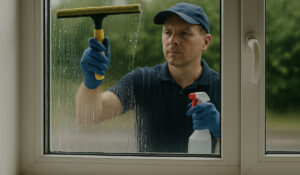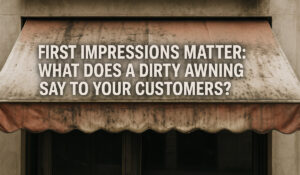When we talk about a business’s image, what usually comes to mind is the logo, the storefront, or the interior design. However, there’s a key element that many business owners overlook: the condition of their awnings. In commercial areas and facades exposed to traffic, awnings act as an extension of the business, and their appearance can influence the first impression a customer receives—positively or negatively.
In this article, we’ll explore why clean awnings could be the differentiating factor your business needs to stand out.
First impressions matter: what does a dirty awning say to your customers?
A dirty, worn, or stained awning can send a negative message to anyone passing by your business: neglect, poor hygiene, or even low product or service quality. 😬 Many consumers decide whether or not to enter a business based solely on its exterior appearance. If the awning looks visibly dirty, customers may assume the inside is just as unkempt.
A clean awning, on the other hand, conveys professionalism, order, and trust. It’s a silent invitation that says: “We care about the details.” 🧼
Moreover, in commercial environments where competition is high, a clean facade can make a customer stop at your business instead of walking past. It’s a form of passive yet effective attraction.
Benefits of keeping awnings clean in high-traffic commercial areas
- Increases business visibility: colors look more vibrant and logos more readable. 🎯
- Enhances perception of quality: customers associate cleanliness with professionalism. 🏆
- Contributes to a positive experience from the first visual contact. 😍
- Extends the life of the awning, saving money on replacements. 💰
- Supports compliance with urban image or commercial regulations. ✅
These benefits go beyond just aesthetics. A clean awning also offers better protection from sun and rain, making entry more comfortable for both customers and staff.
Common awning stains and their impact on material durability
Awnings are constantly exposed to the environment. Common stains include:
- Mold and mildew 🌫️: Caused by trapped moisture and can damage the material.
- Bird droppings 🐦: Highly corrosive and stain fabrics and structures.
- Dust, smoke, and pollution 💨: Accelerate the awning’s visual aging.
- Plant debris 🌿: Like leaves or sap that easily stick to surfaces.
These stains don’t just affect appearance. They also break down materials, weaken seams, and lead to premature tearing.
Cumulative damage from lack of cleaning can result in the loss of waterproof properties or even make the awning a breeding ground for bacteria and pests.
How often should awnings be cleaned? A guide by climate and location
🗓️ The ideal cleaning frequency depends on several factors:
- Urban areas with heavy vehicle traffic: Every 2 months.
- Coastal or humid areas (like Florida): Monthly due to humidity and salinity.
- Awnings under trees or constant shade: Every 6 weeks.
- Dry environments with low exposure: Quarterly.
A monthly inspection to check for stains or buildup is always recommended.
Setting up a maintenance schedule helps avoid costly corrective cleanings. It also allows early detection of wear or structural damage.
Which cleaning methods are safest for your awning type?
🔧 There are different techniques depending on the material:
- Canvas or synthetic fabric: Warm water with neutral soap and a soft brush.
- Vinyl or plastic: Low-pressure washing.
- Metal or rigid structures: Biodegradable degreaser and microfiber cloth.
Avoid harsh or abrasive chemicals. It’s always best to consult a professional if you’re unsure of the exact material type.
Improper use of products or tools can cause fading, fiber damage, or even warping of the awning structure. Prevention starts with the right technique.
Dirty awnings and legal problems: what Florida regulations say about commercial cleaning
🧾 In Florida, local governments often have regulations regarding the exterior image of businesses. In cities like Miami or Tampa, a dirty awning can lead to:
- Fines for violating ordinances.
- Official warning notices.
- License revocation in areas overseen by neighborhood associations.
Keeping clean awnings is not just a good visual practice; in some commercial areas, it’s a legal requirement.
Having a maintenance plan may be part of the requirements for license renewals in commercial or tourist areas, so it should not be overlooked.
Partnering with professionals: advantages of hiring specialized awning cleaning services
💼 Hiring professionals ensures:
- Use of appropriate products for each material.
- Equipment designed to prevent damage or fading.
- Deep cleaning without affecting the surroundings or pedestrians.
- Safety for both staff and the premises.
Professionals also offer maintenance plans that allow for scheduled cleanings.
Relying on experts avoids disruptions to daily business operations, as they can schedule work without affecting business hours.
When should you consult a professional?
📍Clear signs you need to call in a specialist:
- Stains that don’t come off with home cleaning.
- Persistent mold or foul smells.
- Faded or worn-out appearance.
- Leaks or water dripping from the awning onto your storefront.
Early intervention avoids more extensive and costly damage.
It’s also a good idea to hire a professional when acquiring a new location with an existing awning, for a deep initial cleaning before opening to the public.
Don’t underestimate the power of small details. In a competitive commercial environment, clean awnings can make a significant difference in attracting customers. They are not just an aesthetic investment, but a tool to convey order, professionalism, and trust. 💼
A clean awning is more than a spotless canvas; it’s a visual statement of your business identity.
At Sapphire Window Cleaning, we take pride in being your trusted and specialized provider of window cleaning and maintenance services for mid- and high-rise buildings.
Our commitment to excellence, combined with innovative techniques and state-of-the-art equipment, ensures that your property receives the care and attention it deserves, maintaining an impeccable appearance and extending the life of your facilities.
Ready to improve your property’s look and durability? We invite you to learn more about our services by visiting our website or contacting us through this link.
At Sapphire Window Cleaning, we are committed to delivering exceptional quality service and professional attention that exceeds your expectations.
Disclaimer
“Before making decisions that may affect the safety or performance of your property, it is always advisable to seek professional advice.”
✅ 15 FAQs (Frequently Asked Questions)
Why is it essential to keep awnings clean in commercial establishments?
Clean awnings convey professionalism, improve visual appeal, and attract more foot traffic to your storefront.What kind of damage can dirty awnings cause over time?
They can lead to mold growth, fabric deterioration, structural weakening, and a negative business image.How do clean awnings enhance a brand’s visual identity?
They reinforce a clean, organized, and trustworthy perception, essential for customer loyalty and first impressions.What are the most common stains that affect awnings?
Mold, bird droppings, pollution, sap, and mildew are the most frequent contaminants.Can a clean awning really increase customer visits?
Yes, a well-maintained storefront is proven to increase interest and walk-ins, especially in competitive zones.How often should I schedule professional cleaning for my awning?
In Florida, monthly or bimonthly cleaning is recommended due to high humidity and salt exposure.What materials require special care when cleaning awnings?
Canvas, vinyl, and metal all require tailored products and techniques to avoid damage.Are there legal risks to having dirty awnings in Florida?
Yes. Businesses may face fines or warnings if they violate municipal cleanliness codes or HOA regulations.How can I tell if my awning needs replacement instead of cleaning?
If there are tears, persistent odors, discoloration, or mold that cannot be removed, replacement might be necessary.Can awning cleaning be combined with window cleaning services?
Absolutely. Many companies, including Sapphire Window Cleaning, offer both services in a bundled plan.Is power washing safe for all types of awnings?
Not always. Only low-pressure settings are safe for certain fabrics, and professional evaluation is best.Do clean awnings help protect interiors from UV and weather damage?
Yes, they act as a barrier that filters sunlight and rain, contributing to interior preservation.What kind of products are used in eco-friendly awning cleaning?
Biodegradable soaps, low-impact degreasers, and water-efficient techniques are common in sustainable approaches.How much does it cost to clean a commercial awning?
Prices vary based on size, material, and frequency, but routine cleaning prevents costly repairs.Does Sapphire Window Cleaning offer scheduled maintenance plans?
Yes, we provide flexible, tailored plans to keep your awnings clean year-round without hassle.




